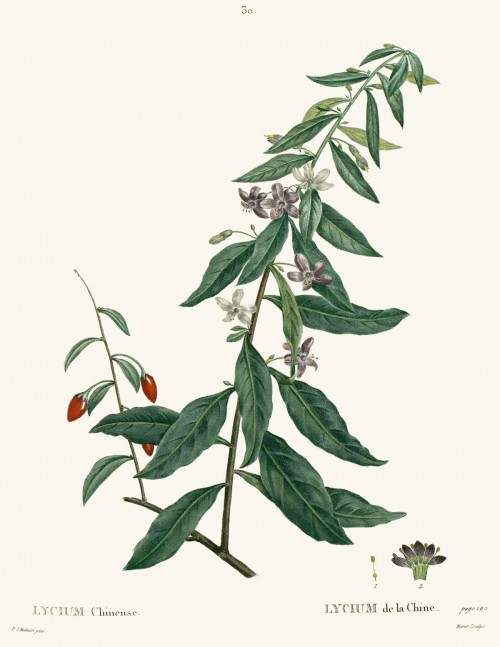Dies ist eine alte Version des Dokuments!
Lycium chinense Mill. - Solanaceae - 枸杞 gou qi (chin.), Chinese wolfberry, Chinese boxthorn, Chinesischer Bocksdorn, Gojibeere
Much branched woody shrub, up to 1m tall; native to eastern Asia, naturalized and cultivated elsewhere; branches with thorns 0.5-2cm; leaves ovate, rhombic, lanceolate, or linear-lanceolate; inflorescences solitary or paired flowers on long shoots or fasciculate among leaves on short shoots; corolla pale purple, 0.9-1.2cm, tube funnel-form, shorter than or subequaling lobes; berry red, ovoid or oblong, ca.2×1cm in cultivation; seeds numerous, yellow, 2.5-3mm. http://www.efloras.org/florataxon.aspx?flora_id=2&taxon_id=200020538
Lycium chinense var. chinense (leaf blade ovate, rhombic, elliptic, or lanceolate; corolla lobes densely ciliate, with distinct basal auricles; stamens slightly shorter than corolla): „Widely cultivated in China as a medicinal plant or vegetable. The fruits are used as a tonic, the root bark is used for relieving cough and reducing fever, the young leaves are eaten as a vegetable, and the seed oil is used as a lubricant and for cooking.“ http://www.efloras.org/florataxon.aspx?flora_id=2&taxon_id=210001171
The fresh or dried berries (of L.chinense, 枸杞 gou qi - or L.barbarum, 宁夏枸杞 ning xia gou qi) are one of the most important traditional medicines in China, mainly used as general tonic to improve blood, strengthnen body, to protect liver (and kidney), and to improve eyesight.
[Medicinal Plants of the World. Ben-Erik Van Wyk and Michael Wink, Pretoria 2004, 195]
„Some volatile compounds found in the dried boxthorn fruit might account for its major odorous property, particularly at relatively high concentration, e g, hexadecanoic acid, (Z,Z)-9,12-octadecadienoic acid, 3-methyl butanal, 2-methyl butanal and 2-furancarboxaldehyde. However, undesirable compounds were also found in the boxthorn fruit including hexanal, 1-octen-3-ol, 3-octanol, 3-hydroxy-2-butanone, and 2,6,6-trimethyl-1,3-cyclohexadien-1-carboxaldehyde.“
[GC-MS analysis of the volatile components in dried boxthorn (Lycium chinensis) fruit., Kim, J.S., Chung, H.Y., Journal of the Korean Society for Applied Biological Chemistry, 52(5), 2009, 516-524]
Like in L.barbarum, the dominating ingredients of the berries are polysaccharides, carotenoids (0.44%), flavanoids (0.15%, main flavanoid rutin). The biggest part of proteoglycans present are arabinogalactanes. Main carotenoid compound is zeaxanthin palmitate (2.2mg/g, 49% of carotenoids) and beside that zeaxanthin, β-carotene and tocopherols.
[Hagers Handbuch der Pharmazeutischen Praxis, Springer 2010]

Duhamel du Monceau, H.L., Traité des arbres et arbustes, Nouvelle édition [Nouveau Duhamel], vol.1 t.30 (1800-1803) [P.J. Redouté]
http://plantgenera.org/species.php?id_species=626862
